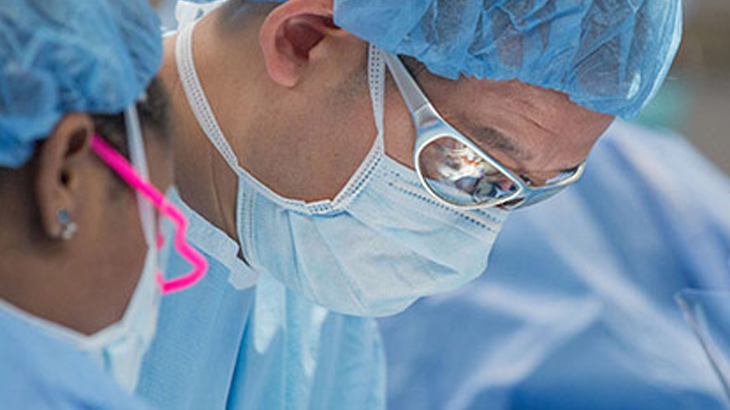
The unique working partnership among the departments of neurology, neurosurgery, orthopedics, neuroradiology, and rehabilitation medicine makes our interdisciplinary approach succeed. The doctors in these specialties are committed to a multidisciplinary approach to patient care, helping to ensure the right diagnosis and the most effective treatment plan. Learn more:
-
Cerebrovascular Surgery
-
CyberKnife for Brain Tumors
-
Deep Brain Stimulation
-
Glioma Treatment
-
Headache Treatments
-
Huntington's Disease Treatment
-
Interventional Neuroradiology
-
Memory Disorder Services
-
Metastatic Tumor Treatments
-
Neurorehabilitation
-
Nerve Decompression
-
Nerve Reconstruction
-
Parkinson's Disease Treatment
-
Sleep Disorders Treatments
-
Skull Base Tumor Surgery
CyberKnife
When you choose CyberKnife treatment at MedStar Health, you can be rest assured that you're getting one of the most advanced treatments for cancer available—and the nation’s most experienced CyberKnife experts.
Though it sounds like a surgical procedure, CyberKnife is actually a painless and non-invasive form of radiation that offers accurate, effective treatment for tumors anywhere in the body—even in places previously considered unreachable. CyberKnife uses a combination of computers, image-guided cameras, and robotic technology to concentrate radiation directly at tumor cells, while limiting radiation exposure to surrounding healthy tissue.
The specialists at MedStar Health use CyberKnife to kill cancerous cells in the brain and spinal cord, as well as to destroy skull base tumors.
Deep brain stimulation (DBS)
Deep brain stimulation (DBS) is based on the same technology used in cardiac pacemakers—it delivers carefully controlled electrical stimulation to precisely targeted areas of the brain that affect movement. The electrical charge interrupts or overrides the brain's faulty signals and, in conjunction with medication, reduces the rigidity, tremors, slow movement, and other symptoms of advanced movement disorders.
In general, you become a candidate for DBS if you:
- Suffer moderate to severe symptoms
- Begin to experience difficulty or side effects with medication, but are still responsive
- Have no indication of dementia
- Are in overall good health
DBS is both reversible and adjustable, making it a vast improvement over other surgeries. As a patient's disease progresses over time, the device can be reprogrammed accordingly to minimize new or increasing symptoms. The device can also be removed entirely to make way for newer treatments, improved techniques, or a medical cure.
Procedure
DBS installation, activation, and programming are a three-part procedure, usually completed over the course of a month to six weeks. It carries no more risk than any other surgical procedure. For many patients, the mere placement of the electrodes is enough to produce immediate improvement. Others may not notice an appreciable difference in symptoms for several months.
Minimally invasive spine surgery
The surgeons at MedStar Health have extensive training and experience in performing microscopic and minimally invasive spinal surgeries.
During minimally invasive procedures, MedStar Health surgeons make a small incision and use advanced computer technology and specialized instruments to repair back and spine conditions. In microscopic surgery, we combine minimally invasive techniques with highly sensitive, cutting-edge surgical microscopes to access even the most delicate areas with precision.
Minimally invasive techniques offer patients:
- Faster recovery time than traditional spinal surgery
- Reduced infection
- Reduced blood loss
- Less scarring
- Faster return to your regular lifestyle
Nerve decompression
Nerve decompression surgery is a minimally invasive surgical procedure to relieve pressure caused by a neuroma, a pinched or entrapped nerve. Your surgeon relieves the pressure on the nerve by cutting tight tunnels around it. This way, even though the nerve is still swollen, there is no pressure on it from surrounding structures in your body, enabling the nerve to start functioning normally again.
Patients suffering symptoms (numbness, pain, and/or functional loss) from such conditions who have not found relief through other, more conservative methods, may consider nerve decompression surgery. The specialists at MedStar Health can address the following with this treatment:
- Upper extremities: Surgery for carpal tunnel, cubital tunnel, or decompression of radial nerve
- Lower extremities: Surgery for femoral nerve, peroneal (foot drop) nerve, tarsal tunnel release
- Trunk: Thigh pain, burning or numbness (called meralgia paresthetica), release of lateral femoral cutaneous nerve
- Chronic migraine headaches: Decompression of nerves in the back, side, and/or front of the head
- Diabetic neuropathy
Follow-up
Surgery can relieve symptoms and halt further damage; however, it does not change the underlying problems. A person whose job requires repetitive wrist movements is still susceptible to nerve dysfunction. People with diabetes will continue to have swollen nerves that are more prone to compression and damage.
Most patients have repeat neurosensory testing six to twelve weeks after surgery. This determines if the nerves are repairing themselves and if function is improving. Most patients, especially those with diabetes, should undergo neurosensory testing each year to detect possible new nerve damage and measure the progress of existing nerve damage.
Nerve reconstruction surgery
In order to preserve function when nerves are damaged, surgeons use microsurgical suturing techniques. However, surgeons are often not able to reconnect the nerve fibers because of the amount of damage at the injury site. Instead, our surgeons use a combination of the following to repair the nerves:
- Nerve conduits (tubes to bridge small nerve defects)
- Nerve allografts (processed human nerve to bridge small-large nerve gaps)
- Nerve allografts (used from the patient him/herself from other, less critical nerves)
Some examples of the types of injuries that are appropriate for this treatment include:
- Hand/finger injuries with sharp objects (usually knife) resulting in scar, pain, and/or numbness
- Traumatic or surgical injuries of any major upper or lower extremity nerve injury resulting in acute or delayed loss of the nerve function
- Nerve deficit following nerve tumor removal
- Peroneal nerve neuropathy
Repairs such as these should ideally be done immediately (same day). If that is not possible, every attempt should be made to perform nerve repair within three to four weeks. After that period, it's possible there will be irreversible loss of nerve function. Once the nerve is reconstructed, it recovers at a rate of approximately one half millimeter to one millimeter per day.
Our providers

Expert neurosurgery care
Getting the care you need starts with seeing one of our neurosurgical specialists.









